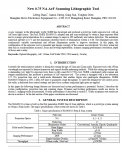yes, Nikon has to use faster stage and higher power laser just to keep up with the dual stage system's throughput.That is why i avoid posting posts from social media like twitter or rumors that people say, the part of the delivering of lithography machines to Chinese fabs is public knowledge that you can find in some financial documentation in the Chinese internet BUT the part were he says that SMEE is purposely fitting single wafers stages machines with dual wafer stages I haven't found it anywhere, i am reading from top to bottom. AND COURSE A SINGLE WAFER STAGES ARE GOING TO BE LOWER YIELD THAN DUAL STAGE,And specially comparing SMEE and ASML, unless you use a very powerful ligth source and very high speed stage.
Even the all powerful Nikon single stage I-line scanners have lower yield than the ASML dual stage one. 200 vs 230 wph. THAT IS JUST LOGIC.
View attachment 93795View attachment 93796
Now i have a curiosity that i can't satisfy because i can't find any reliable information, just because a post of a guy in forum.
So, going along this line of discussion......Canon also uses single stage and their iLine and KrF throughput seems to be same or better than ASML's. That's actually pretty impressive.
For iLine and KrF I think dual stage is not a good approach. This adds extra costs to the system. Canon and Nikon able to take bigger share business from ASML in iLine and KrF because their systems are more economical and could still get the job done.
So I wonder why SMEE took the dual stage approach for their iLine and KrF. They must really like ASML's technical approach: their SSA600 looks like a copy of ASML PAS system, and now hey are building a complete line of iLine/KrF/ArF as an approximate improved copies of ASML XT dual stage platform systems.
In my opinion, SMEE should have stuck with single-stage approach to have a better tool-cost per wafer-output performance.
Last edited:

